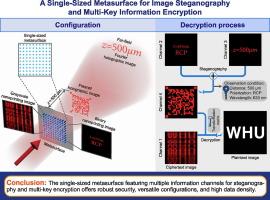A Single-Sized Metasurface for Image Steganography and Multi-Key Information Encryption
IF 10.1
1区 工程技术
Q1 ENGINEERING, MULTIDISCIPLINARY
引用次数: 0
Abstract
With the escalating flow of information and digital communication, information security has become an increasingly important issue. Traditional cryptographic methods are being threatened by advancing progress in computing, while physical encryption methods are favored as a viable and compelling avenue. Metasurfaces, which are known for their extraordinary ability to manipulate optical parameters at the nanoscale, exhibit significant potential for the revolution of optical devices, making them a highly promising candidate for optical encryption applications. Here, a single-sized metasurface with four independent channels is proposed for conducting steganography and multi-key information encryption. More specifically, plaintext is transformed into a ciphertext image, which is encoded into a metasurface, while the decryption key is discretely integrated into another channel within the same metasurface. Two different keys for steganographic image unveiling are also encoded into the metasurface and can be retrieved with different channels and spatial positions. This distributed multi-key encryption approach can enhance security, while strategically distributing images across distinct spatial zones serves as an additional measure to reduce the risk of information leakage. This minimalist designed metasurface, with its advantages of high information density and robust security, holds promise across applications including portable encryption, high-camouflaged image display, and high-density optical storage.

用于图像隐写术和多密钥信息加密的单尺寸元表面
随着信息流和数字通信的不断升级,信息安全已成为一个日益重要的问题。传统的加密方法正受到计算技术进步的威胁,而物理加密方法作为一种可行且引人注目的途径受到青睐。元表面以其在纳米尺度上操纵光学参数的非凡能力而著称,在光学设备革命中展现出巨大的潜力,使其成为光学加密应用中极具前景的候选材料。本文提出了一种具有四个独立通道的单尺寸元表面,用于进行隐写术和多密钥信息加密。更具体地说,明文被转化为密文图像,并被编码到元表面中,而解密密钥则被分离地集成到同一元表面中的另一个通道中。用于揭示隐写图像的两个不同密钥也被编码到元表面中,并可通过不同的通道和空间位置进行检索。这种分布式多密钥加密方法可以提高安全性,而战略性地将图像分布在不同的空间区域则是降低信息泄漏风险的额外措施。这种设计简约的元表面具有信息密度高和安全性强的优点,在便携式加密、高伪装图像显示和高密度光存储等应用领域大有可为。
本文章由计算机程序翻译,如有差异,请以英文原文为准。
求助全文
约1分钟内获得全文
求助全文
来源期刊

Engineering
Environmental Science-Environmental Engineering
自引率
1.60%
发文量
335
审稿时长
35 days
期刊介绍:
Engineering, an international open-access journal initiated by the Chinese Academy of Engineering (CAE) in 2015, serves as a distinguished platform for disseminating cutting-edge advancements in engineering R&D, sharing major research outputs, and highlighting key achievements worldwide. The journal's objectives encompass reporting progress in engineering science, fostering discussions on hot topics, addressing areas of interest, challenges, and prospects in engineering development, while considering human and environmental well-being and ethics in engineering. It aims to inspire breakthroughs and innovations with profound economic and social significance, propelling them to advanced international standards and transforming them into a new productive force. Ultimately, this endeavor seeks to bring about positive changes globally, benefit humanity, and shape a new future.
 求助内容:
求助内容: 应助结果提醒方式:
应助结果提醒方式:


